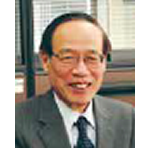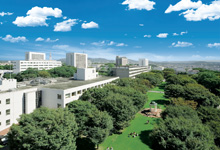Interview with the President's Special Advisor Toshio Goto
 Completed the doctoral course at the Graduate School of Engineering, Nagoya University in 1969, and became a doctor of engineering. 1986 Professor at Nagoya University.Dean, Deputy President, Graduate School of Engineering, Nagoya University, Dean of the Institute of Advanced Studies. 2005 Professor at Chubu University.After working as a vice president, director, and director of the university-wide common education department, he is currently a special advisor to the president.He has served as a member of the Science Council of Japan, chairman of the Japan Society of Applied Physics, and a member of the council of the Ministry of Economy, Trade and Industry.Received the Minister of Education, Science and Technology Award, the Minister of Science and Technology Policy Award, the Japan Society of Applied Physics Paper Award, and the US IEEE Fellow Award.His specialty is the field of optical and electronic information, which is an indispensable basic technology in the current aerospace field.At the Science Council of Japan, he has served as the chairman of the Comprehensive Engineering Committee, which covers the field of aerospace, and has overlooked the movement and development of this field in Japan.Born in Aichi Prefectural Asahigaoka High School.
Completed the doctoral course at the Graduate School of Engineering, Nagoya University in 1969, and became a doctor of engineering. 1986 Professor at Nagoya University.Dean, Deputy President, Graduate School of Engineering, Nagoya University, Dean of the Institute of Advanced Studies. 2005 Professor at Chubu University.After working as a vice president, director, and director of the university-wide common education department, he is currently a special advisor to the president.He has served as a member of the Science Council of Japan, chairman of the Japan Society of Applied Physics, and a member of the council of the Ministry of Economy, Trade and Industry.Received the Minister of Education, Science and Technology Award, the Minister of Science and Technology Policy Award, the Japan Society of Applied Physics Paper Award, and the US IEEE Fellow Award.His specialty is the field of optical and electronic information, which is an indispensable basic technology in the current aerospace field.At the Science Council of Japan, he has served as the chairman of the Comprehensive Engineering Committee, which covers the field of aerospace, and has overlooked the movement and development of this field in Japan.Born in Aichi Prefectural Asahigaoka High School.
Expectations for Japan's aerospace industry have risen sharply in recent years. Not only the aircraft symbolized by MRJ, but also Japanese rockets with a high probability of successful launch are gaining worldwide trust.Japan's aerospace industry has been lagging behind the developed countries of the United States and France for a long time after the war, but it has finally come into the limelight, and the country is also positioned as Japan's future core industry, and attention is also paid to human resource development for that purpose. I started to do it.
Since the aerospace industry needs a wider base than automobiles and cannot be established by major manufacturers alone, it is urgent to develop small and medium-sized enterprises in the region.In the past, some researchers involved in design and new technology development were sufficient for human resources, but in the future, it is expected that a large number of leaders at manufacturing sites and leaders of small and medium-sized enterprises will be required.
On the other hand, the educational organizations in the field of aerospace at the university are currently located at some universities of the former imperial university and several private universities in the Kanto region, and only at Nagoya University in the Chubu area.Moreover, the capacity is only about 20 people.Therefore, the university decided to open the Department of Aerospace Science and Engineering in 80 in order to utilize the power and the advantage of the earth that it has accumulated since its establishment as the Faculty of Engineering.The capacity is XNUMX people, and if the development of MRJ proceeds as planned, graduates should be able to witness the mass production period.
Aerospace science and engineering belongs to comprehensive engineering.From machinery and materials to electrical / electronic and information, it is necessary to receive conventional specialized education, acquire elemental technologies, and have the ability to integrate the whole as a system.Industry-government-academia collaborative education is most suitable for such engineer training.
Production technology within the university is limited so that aircraft cannot be assembled at the university.The faculty composition will also reflect recent technological innovations and increase the weight of electrical / electronic and information systems from the conventional mechanical and material-centered configurations, but few can teach everything from practical technology to practical technology.Therefore, after learning the necessary basics at the university, from the second or third year onward, we will actually go to the manufacturing site of the company and conduct factory tours and factory training.We also plan to use resources outside the university to provide practical technology education, such as increasing the number of lectures with a visiting professor in charge of the company.This will make it easier to train engineers who have both basic and ready-to-work skills, improve matching for employment and recruitment, and can be expected to have a ripple effect on improving the education of existing departments.
With the opening of the Department of Aeronautics and Astronautics, we will take on the challenge of integration and integration, which are the challenges of engineering in the 21st century. I also want to contribute to.

